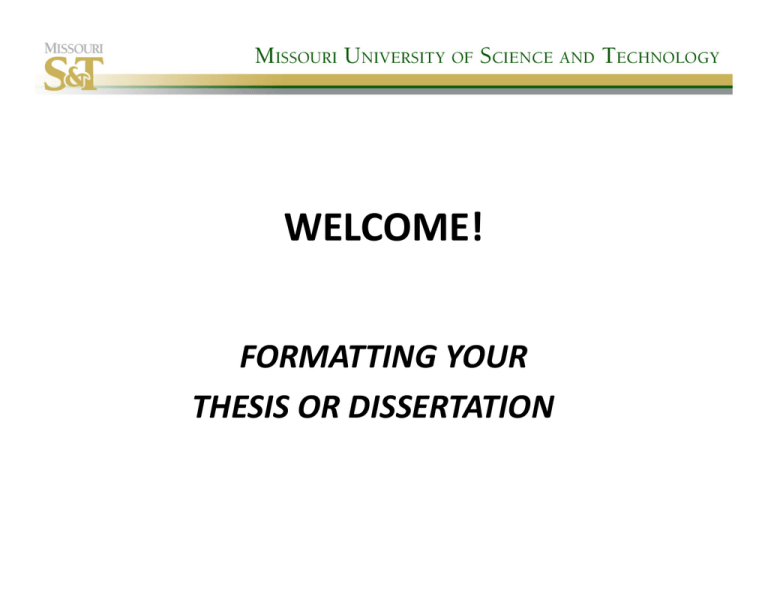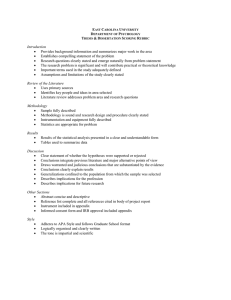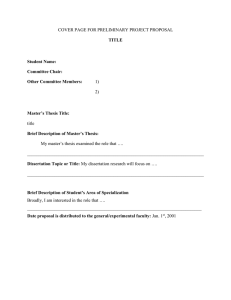
WELCOME!
FORMATTING YOUR THESIS OR DISSERTATION
Why is the format of your dissertation or thesis important?
• forms immediate first impression
• makes it easier to read and understand
• lends credibility to content
Overview
Reference Materials
• Specifications (Rules) • Templates (MS, PhD)
• Publication Option
• http://grad.mst.edu – Current Students – Theses & Dissertations
• A Manual for Writers of Term Papers, Theses, and Dissertations, 6th ed., by Kate L. Turabian Most common mistakes
• In accordance with policy established by the Graduate Faculty, it is the responsibility of the advisory committee to see that theses and dissertations are edited for spelling, grammar, organization, stylistic consistency, completeness, and agreement between the Table of Contents and the contents. • The Office of Graduate Studies is responsible for maintaining specifications necessary for the processing, microfilming, binding and storing of theses and dissertations, and for the maintenance of some uniformity of organization. FIRST THINGS FIRST
• Margins must be 1 ½” left, 1” top, right, bottom
• Font size must be at least 11 point. 12 point is preferable for microfilming.
• Must be at least 1.5 line spacing, Double spaced is better for microfilming.
• Paragraphs must be indented ½” consistently.
BE CONSISTENT!
Preliminary pages (front matter):
•Front flyleaf (a blank cover sheet of paper)
•Title page •Blank page or copyright notice
•Publication thesis/dissertation option (if applicable) •Abstract (250 to 350 words, one page maximum)
Preface (recommended but not required)
•Acknowledgments
•Table of Contents •List of Illustrations •List of Tables
•List of Maps
List of Abbreviations or Nomenclature
Glossary
Text:
•Body of thesis or dissertation (includes text, illustrations, and tables)
Back Matter:
•Appendices
Endnotes (Microfilm readers prefer footnotes)
•Bibliography or references Index
•Vita Addendum
Back flyleaf (a blank cover sheet of paper)
Example: Thesis Title Page
EFFECTIVE LAND‐USE OF THE MISSOURI
DAM SITE AREAS
by
JOHN HENRY MINER
A THESIS
Presented to the Faculty of the Graduate School of the
MISSOURI UNIVERSITY OF SCIENCE AND TECHNOLOGY
In Partial Fulfillment of the Requirements for the Degree
MASTER OF SCIENCE IN CERAMIC ENGINEERING
2008
Approved by:
John D. Snow, Advisor
Ralph L. Winter
C. Randolf Fall
EXPERT SYSTEMS FOR THE SELECTION AND EVALUATION OF
Example: Dissertation Title Page
TWO‐PHASE CONVECTIVE HEAT TRANSFER COEFFICIENTS
by
ELIZABETH ELAINE CARNOT
A DISSERTATION
Presented to the Faculty of the Graduate School of the
MISSOURI UNIVERSITY OF SCIENCE AND TECHNOLOGY
In Partial Fulfillment of the Requirements for the Degree
DOCTOR OF PHILOSOPHY
in
MECHANICAL ENGINEERING
2008
Approved by:
Robert Smith, Advisor
James B. Brown
Charles R. Jones
D. F. Ling
Hardy Davidson
Blank or Copyright Page
© 20XX AUTHOR’S FULL LEGAL NAME
ALL RIGHTS RESERVED
Eric W. Anderson
Licensing Associate
Tech Commercial & Econ Development
341‐4551
203 University Center
ericwa@mst.edu
ABSTRACT
• One page only, double spaced
• The abstract should be a concise, clear statement of the important points which have been brought out in the Thesis or Dissertation. It should summarize the problems dealt with by the research, the methods employed, and the major findings. As a digest of the entire thesis or dissertation, the abstract should be organized to correlate with the thesis/dissertation outline. PUBLICATIONS THESIS* OPTION
Available for THESIS * or DISSERTATION (T/D)
Must submit with the T/D a copy of the specifications for writers from the journal to which the T/D is submitted, or a reprint of a sample article.
• Publication option is allowed when the T/D is prepared with the objective of publication in a professional journal. The Office of Graduate Studies will accept conventional T/Ds written in the format prescribed by the style manual of the intended journal. However, the T/D must adhere to S&T margins and minimum print size requirements. Each T/D should include the following sections:
•
•
Preliminary pages (including Publication Thesis/Dissertation Option page, see Attachment D in specs) –
–
–
–
–
Introduction
Review of literature
Journal articles
Conclusions
Back matter
ACKNOWLEDGEMENTS
• It is customary to acknowledge graduate fellowships, grants, travel funds, and any special help you may have received outside your committee (from adjunct professors, library staff, or others) that led to the completion of your research.
• Can be written in 1st person. Watch grammar and spelling.
TABLE OF CONTENTS
Page
ABSTRACT …………………………………………………….......iii
ACKNOWLEDGEMENTS......….........…………..………….iv
LIST OF ILLUSTRATIONS……........…………..................vii
LIST OF TABLES……….……………........………………………ix
NOMENCLATURE ………………………………………………xi
SECTION
1. INTRODUCTION…………………………..………………….1
1.1 TITLE………………………..…………..………………..…2
1.2 TITLE……………………..………………………………....3
1.2.1 Third Level Heading…..…..…………..……4
1.2.2 Title …..….……..………………….……..………5
1.2.2.1 Fourth level heading …..……...6
2. LITERATURE REVIEW……..…………………………….…8
3. BODY OF TEXT …………..…………………………..….10
4. CONCLUSIONS……………..………………………….…..15
For one appendix:
APPENDIX ………………………………………………………………20
BIBLIOGRAPHY………..……....................…………………... 22
VITA…………….……………………………….....…………………… 25
For two or more:
APPENDICES
A. TITLE …..…..........………………..…………………..17
B. TITLE…..…..........………………..………………….. 20
BIBLIOGRAPHY……..………....................…………………... 22
VITA…………….……………………………….....…………………… 25
PLEASE NOTE:
• Capitalization and wording of headings or subheadings should be the same in the Table of Contents as in the text ……….………………………………9
• Single space run over lines within headings, double space between headings or subheadings…….......10
LIST OF ILLUSTRATIONS
Figure Page
1.1 Title of Figure ………………………………………….2
1.2 Second figure title ………….……………………….3
2.1 First figure in 2nd Section ………..….……………5
or
Page
Figure 1.1 title …………………………..………………...2
LIST OF TABLES
Table Page
1.1 Table Title Here ……………………………………….8
2.1 Next Table Title…………..………………………...10
or
Page
Table 1.1 Title …………….…..……………………………8
TABLE OF CONTENTS
Page
PUBLICATION THESIS/DISSERTATION* OPTION. …………………..…..……………….iii
ABSTRACT ………………………......................................……….……….……………….…iv
ACKNOWLEDGEMENTS …………………………….........…………..…………………………..v
LIST OF ILLUSTRATIONS………………..……........…………......................................vii
LIST OF TABLES …………………………..………………………….…........……………………….ix
NOMENCLATURE …………………………..……………………….………………………………xi
Table of Contents, continued
SECTION
1. INTRODUCTION …………………………………………..…….....……..………………….1
2. LITERATURE REVIEW ………………………………………….........…...…..……………8
PAPER
I. FIRST PAPER TITLE ……………………………………………....……………..…………..10
Abstract ….………………………………………..…………..…………………..…………..10
1. Introduction .………………………………………………………………………………11
Subheading …………………………………………………………..…………………………………11
References …………………………………………………….………………………………………..15
II. Paper Two Title ……………………………………………………………..…………….. 20
SECTION
3. CONCLUSIONS ……………………………………………..……………….……………….30
VITA ………………………………………………………………………………………………………..35
LIST OF ILLUSTRATIONS
Figure Page Section 1
1.1 Title …………..……………… …..…………………………………………10
Paper I
1. Title …………..……………..………………………………………..........15
Paper II
1. Title …………..……………….……………………………………………...20
Section 2
2.1 Title ………….……………………......……………………………………30
NOMENCLATURE
Symbol
Description
α
alpha
µ mu
1. INTRODUCTION
• No visible page number on this page.
• Three blank lines between heading and text.
• Three blank lines before 2nd level headings.
1.1 SECOND LEVEL HEADING
Start text as a paragraph.
1.1.1 Third Level Headings. These subheadings are
indented ½”, should be in bold, end in a period, and
have text follow immediately after period. Each major
word in this level heading begins with a capital letter.
No extra line spacing is before this level of heading.
1.1.1.1 Fourth level headings. Same as 3rd level
headings but have only the first word of the heading
begin with a capital letter.
1.1.1.1.1 Fifth level headings. Same as 3rd and 4th
but should also be underlined. Try to avoid past 4th
level. Try bulleted items.
• Avoid using first person, personal pronouns in writing. My, me, I, our, etc. as a rule should not be used in formal writing.
• Try to fill pages as close as possible to the 1” bottom margin. Avoid too much white space.
• Font size and style must be consistent throughout, including page numbers, equations, etc.
• Lines under equations should not be indented except when beginning a new paragraph.
2. Figures and Tables
• Figures title below; table titles above
• All figures and tables must be mentioned by number in text BEFORE they appear. Mention in consecutive order in the order in which they appear and as soon as possible after they are first mentioned in text.
• Must have 4 blank spaces before and after all figures and tables in text.
• Consistency in placement of figures and figure titles.
• Consistent use of period (or no period) at the end of figure titles.
2. Figures and Tables (cont.)
• When you split a figure or table over two pages (or more), include figure/table number, title and “(cont.)” on the following figures or tables. Use the first page it appears as page number in List of Illustrations/List of Tables.
• Common figure title for figures with (a), (b), etc. Use actual figure title in List of Illustrations.
• Be sure figures are readable.
APPENDIX
TITLE
• When you have only one appendix, put this heading on the first page of the appendix. Do not use a letter or title page.
• Appendix is considered extra information, not an actual part of the Thesis or Dissertation. Do not include appendix figures or tables in List of Illustration/List of Tables.
• Maintain margins and page numbering
• Lengthy appendices can be put on CD
– 2 copies of CD for MS
– 3 copies of CD for PhD
APPENDICES
• If you have more than one appendix, include a title page for each appendix.
• There should be no visible page number on the title pages, but the title page number is listed in the Table of Contents.
Example
APPENDIX A
TITLE
Example
APPENDIX B
VISUAL BASIC CODE, PRINTOUTS & PLOTS ON CD‐ROM
1. INTRODUCTION
Included with this T/D is a CD‐ROM, which contains the VISUAL BASIC CODE of all fourteen original warrant‐pricing models, the statistical test printouts and plots from the Phase II, Phase III and Phase IV of this study. Each module of the VISUAL BASIC CODE has been developed using VISUAL BASIC for Microsoft Excel 97. All documents have been prepared as Microsoft Word 97 document files (Windows 98). An outline of the contents of the CD‐ROM is as follows.
2. CONTENTS
Info.TXT
VISUAL BASIC Programs:
Code.DOC
Example
Printouts & Plots:
Phase II.DOC
Phase III.DOC
Phase IV.DOC
Example
BIBLIOGRAPHY
1.
David J. Griffiths, Introduction to Electrodynamics, 3rd Ed., Prentice Hall: Upper Saddle River, New Jersey (1999).
2.
William H. Hayt, Jr. and John A. Buck, Engineering Electromagnetics, 6th Ed., McGraw Hill: Boston (2001). 3.
T.G. Cowling, Magnetohydrodynamics, Interscience Pubs.: New York (1957).
[4]
E.L. Resler, Jr. and W.R. Sears, “The Prospects for Magneto‐Aerodynamics,” Journal of
Aerospace Science, Vol. 25, No. 4, Pp. 235‐245, 258 (1958).
[5]
Niksun Customer Support, 2003.
http://www.niksun.com/, pp 2‐51.
“Niksun Net X User’s Guide,” Niksun website
Griffiths, David J., Introduction to Electrodynamics, 3rd Ed., Prentice Hall: Upper Saddle River,
New Jersey (1999).
Resler, Jr., E.L., and W.R. Sears, “The Prospects for Magneto‐Aerodynamics,” Journal of
Aerospace Science, Vol. 25, No. 4, Pp. 235‐245, 258 (1958).
VITA
• Must include Date of Birth
• Should include all degrees awarded with at least the year they were awarded
• Should be one page only
These pages should have NO visible page numbers:
Title Page
Copyright or blank page
Page 1
Appendix Title Pages
Front Matter (title page‐Nomenclature),use lowercase Roman numerals i, ii, iii, iv, etc.
• Body of Text – Vita, use Arabic numerals 1, 2, etc.
•
•
•
•
•
Final Library Copy
• Quality white paper with watermark
– at least 25% cotton content
– at least 16 pound weight
• The Library copy is the official copy and is submitted to the Office of Graduate Studies
• Graduate Catalog recommends
– Original Library Copy
– 3 copies, you, your advisor, your department
QUESTIONS, COMMENTS?
Email: mstgrad@mst.edu



